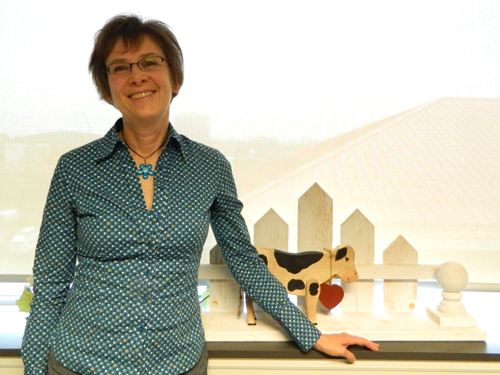
Quilting bees. Threshing bees. Barn-raisings. Friendly, hard-working neighbours gathering together to get things done. It’s one of those rural traditions that we tend to look back on nostalgically.
But there’s another side to these “bees,” says history professor Catharine Wilson. Sometimes, everything went wrong. “There were serious, sometimes fatal, accidents and fights frequently broke out. Some turned into major brawls. I even found information about 16 cases of murder at the bees or right afterwards.”
She calls them “bees-gone-wrong.”
Wilson will share some of the stories she’s uncovered as the first speaker of this year’s Rural History Roundtable. Her talk, “’Bees-Gone-Wrong’: The Untold Story about Neighbourhoods and the Good Old Days of Threshing and Barn-Raising Bees in Ontario,” will be held Jan. 23 from 2:30 to 4:30 p.m. in Johnston Hall.
She’s especially pleased that her talk kicks off the 10th anniversary year of the roundtable, a series of presentations initiated in 2002 by Prof. Doug McCalla, Canada Research Chair in Rural History at U of G. “It’s exciting to see how it has grown over the years,” says Wilson. “In 2011, we had 14 speakers.” The continued success of the event, she adds, reflects the strength of scholarship on rural life at the University as well as the interest among students and faculty.
“We have the best collection of Canadian rural sources in our archives,” Wilson points out, “and a high level of innovative research being done.”
Not all the speakers are from U of G; the roundtable has attracted historians from Brazil, Cuba, the United States, the United Kingdom and other parts of Canada. “It’s a great opportunity for students and faculty to meet experts in the field,” says Wilson. The varied topics also attract an audience that includes people from many U of G departments, primarily those interested in agriculture, veterinary medicine, geography, sociology, and the University’s library archives, as well as alumni and visitors from other universities.
Visit the Department of History website for more details about speakers and topics for 2012.
Wilson became interested in work bees because she feels they provide windows into understanding how rural neighbourhoods functioned and how families worked together to accomplish things they couldn’t have done on their own. Gathering together neighbours to raise a barn or thresh the harvested grain made sense, and most of the time it worked well, according to reports and descriptions in the farm diaries she uses as her sources for information about this topic.

But as Wilson points out, managing any large group of people is never easy. Mix in heavy farm equipment, and perhaps some disasters are inevitable.
“I found over 100 serious accidents in my research, where people were killed or severely injured,” she says. Some may have been due to negligence, but many could be attributed to inexperience or someone simply slipping and falling.
Fights were also quite common, perhaps in part because whiskey was often handed out freely at these events. Wilson adds that the public nature of the bees made them a popular place for people to air grievances. Disagreements were usually settled without physical violence, but some turned into full-fledged brawls, with people taking sides and joining in the battle. “They would just grab whatever weapons were handy – pitchforks, butchering knives, poles,” says Wilson.
Sometimes the violence happened after the bee. A man might see his wife flirt with another man, have a few too many drinks and attack her after they got home, for example.
Wilson is especially interested in seeing how the community responded to these “breaches of the code of neighbourliness.” What happened when someone was injured in an accident, or when one person killed another?
For the most part, the community pulled together. “When there was an accident, the community rallied around to help and support the injured person, or if that person had died, his or her family,” Wilson says. “If negligence was suspected, the community usually tried to diffuse the blame. There was a group sense of responsibility.”
When fights got out of hand, Wilson found the others at the bee became “first responders” trying to end the fight, control the damage and help the injured person. “If the aggressor was really dangerous, they called in the authorities,” she says. “The victim or victim’s family would be cared for, sometimes for many years.”
If the authorities didn’t deal with the aggressor, the community would. “There was a case of a man in Dufferin who was Catholic but pretended to be Protestant so he could take part in the Protestant bees. When he was found out, a fight ensued, and he murdered another farmer, a neighbour. He fled to the United States, but the community continued to hound his family until they also fled,” says Wilson.
In another case, a young man in Wellington County was disappointed when he asked a woman to marry him and she refused. After seeing her dance with others at the post-barn-raising party, he followed her when she left and stabbed her. The young woman lived, but the community gathered together a posse to search for the man all night. His parents eventually persuaded him to give himself up to the police.
“The community clearly supported that young woman,” says Wilson.
The “bees-gone-wrong” anecdotes – and what they tell us about neighbourhoods – will be one chapter of the book Wilson is writing about work bees. Wilson’s “Beeing Neighbours” project is funded by a Social Science and Humanities Research Council Grant.
That project will be completed more quickly if she can keep herself from being distracted. “You can easily get lost for hours just reading some of the stories,” she says.